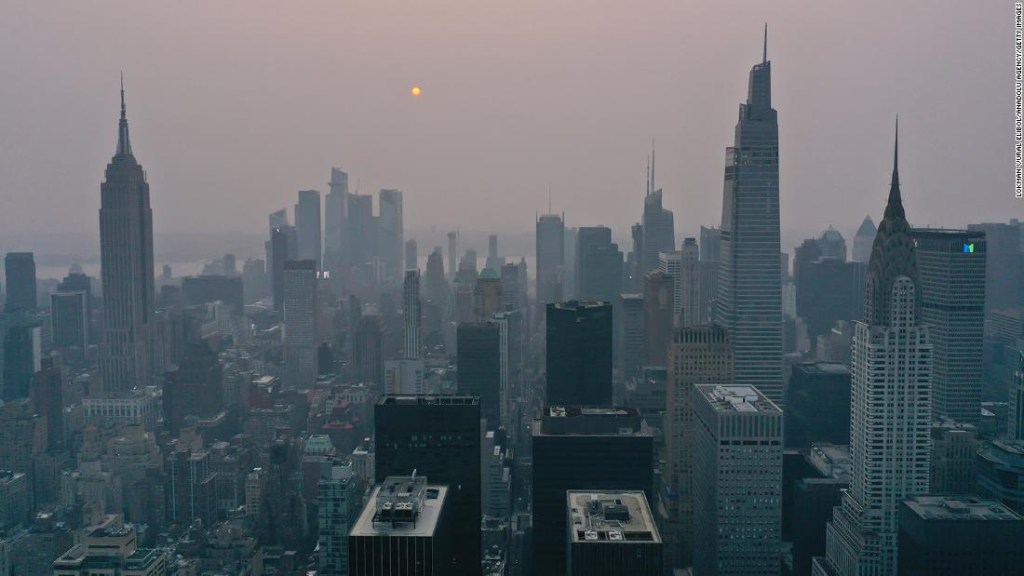Fires in Siberia and Canada alarm experts 0:52
(CNN) -
Yakutsk, in Russian Siberia, is known as the coldest city in the world. In a place where a mere exposed nose during the winter months can cause throbbing pain, people are used to taking precautions against freezing temperatures, including taking extra time in the morning to dress in lots of layers.
But now the city is shrouded in haze as nearby wildfires ravage parched forests after weeks of heat waves. The fires are so big, and the winds so strong, that smoke is traveling all the way to Alaska.
In the United States, the Bootleg Wildfire in Oregon has grown into a monstrous complex with its own climate, sending dense smoke some 5,000 kilometers from one end of the continent to the other.
New York City woke up Wednesday to an intense red sunrise, the smell of wildfires and a thick brown haze.
The Bootleg fire in Oregon is so big it's creating its own climate
Firefighters from both countries, as well as from British Columbia in Canada, are fighting an almost impossible battle to smother hell with water pumps and hoses, and prevent their spread by digging fire barriers.
An aerial view shows a forest fire in Yakutia, Russia.
Wildfires raging in the western United States send the haze across the continent to New York City on July 20.
Smoke in Siberia's Yukutia Republic was so thick Tuesday that reconnaissance pilot Svyatoslav Kolesov couldn't do his job.
There was no way he could fly his plane in such poor visibility.
Kolesov is a senior pilot for an aerial observation post in Russia's far eastern Yakutia region.
This part of Siberia is prone to forest fires, as much of the region is covered with forests.
But Kolesov told CNN that the flames are different this year.
"New fires have appeared in northern Yakutia, in places where there were no fires last year and where they had not burned at all before," he said.
advertising
Kolesov is seeing first-hand what scientists have been warning of for years.
Forest fires are getting bigger and more intense and also occur in places that are not used to them.
"The fire season is getting longer, the fires are getting bigger and burning hotter than ever," says Thomas Smith, Associate Professor of Environmental Geography at the London School of Economics.
Employees of the Yakutlesresurs forest protection service rest while digging a fire pit to stop a fire on the outskirts of the Yakutia town of Magaras.
Many factors, such as poor soil management, influence forest fires, but climate change makes them more frequent and intense.
Most of Europe, the western US, southwestern Canada and some regions of South America experienced drier than average conditions in June, according to the Copernicus Climate Change Service, turning forests into powder kegs.
Mexicans will fight to extinguish fires in Canada 0:48
Wildfires in Yakutia have consumed more than 26 million hectares since the beginning of the year, according to figures released by the country's Aviation Forest Protection Service.
That equates to nearly 5 million soccer fields.
Recent evolution of the Bootleg fire
Red: Fire source Light red: Fire perimeter Orange: Spotlight (24 hours) Yellow: Spotlight (48 hours)
Source: National Interagency Fire Center, VIIRS-SNPP, EPA AirNow, National Oceanic and Atmospheric Administration (NOAA)
Trees burn along Highway 89 during the Tamarack Fire in the Californian city of Markleeville on July 17.
In Oregon, eight fires have burned nearly 200,000 acres so far, in a fire season that officials say is unlike any seen before.
The Bootleg fire is so big and generates so much energy and extreme heat that it is creating its own clouds and thunderstorms.
The Canadian province of British Columbia declared a state of emergency over the wildfires on Wednesday.
Almost 300 active forest fires have been registered in the province.
Education and fire mitigation specialist Ryan Berlin (left) and Bob Dillon observe the smoke cloud from the Bootleg fire from Dillon's home in Beatty, Oregon, on July 16, 2021.
The Bootleg Fire lights up the sky at night near Bly in Oregon on July 16.
Wildfires are part of a vicious climate cycle.
Climate change not only fuels fires, their burning releases even more carbon into the atmosphere, exacerbating the crisis.
Some scientists say this year's fires are especially serious.
"As of mid-July, the total estimated emissions are higher than many previous years for the summer periods, showing that this is a very persistent problem," said Mark Parrington, chief scientist with the Atmospheric Watch Service. of Copernicus.
Unprecedented heat, hundreds of deaths and a destroyed city.
Climate change is scorching the northern hemisphere
According to him, Yakutia has been experiencing intense fires continuously since the last days of June.
"If I look at the time series, we see kind of equivalent levels of intensity, but not for three weeks, you know, I think the longest one before was maybe a couple of weeks or 10 days or something like that, so much more isolated." he said, adding that the fire season typically lasts until mid-August, so the fires are likely to continue.
More frequent and more intense
Smith noted that although forest fires have always occurred in some areas of Siberia and Canada, the worrying thing is that they are now much more frequent.
"Before there was a fire every 100 or 150 years in a place, which means that the forest regenerates completely and ends with a mature forest, and then the fire comes and starts again," he said.
"What we are seeing in some parts of eastern Siberia is that fires now occur every 10 or 30 years, in some places, and what that means is that the forest is not going to be able to mature, and you end up with a change. [from ecosystem] to a kind of shrub land or swampy grassland. "
Burned-out cars and structures are seen in Lytton, British Columbia, on Friday, July 9, 2021.
A helicopter prepares to drop a water bomb as smoke spreads across the Fraser River Valley near Lytton, British Columbia, Canada, Friday, July 2, 2021.
Heat waves and droughts are also making new areas vulnerable to fires.
More than 520,000 hectares have been lost to fires in the US 4:35
"In the Siberian Arctic, we are concerned about the tundra ecosystem north of the forest, this would normally be too wet or frozen to burn," Smith said.
"In the last two years we have seen a lot of fires in this ecosystem, which suggests that things are changing there."
This also has a serious long-term effect on the climate.
Ash from fires could also accelerate global warming by darkening surfaces that would normally be lighter in color and reflect more solar radiation.
Areas affected by these fires also include peatlands, which are some of the most efficient carbon stores on the planet, Parrington said.
"If they catch fire, you are releasing carbon," Parrington said.
"A carbon storage system that has been there for thousands of years is being phased out, so it can have a knock-on impact," he warned.
Zarah Ullah, Anna Chernova and Darya Tarasova from Moscow and Augusta Anthony contributed to this report. Photo editing by Sarah Tilotta.
Canada Wildfires Siberia



/cloudfront-eu-central-1.images.arcpublishing.com/prisa/GE2HIPPGSREYXNPF3G7BWKT62U.JPG)
/cloudfront-eu-central-1.images.arcpublishing.com/prisa/RSVSTQFDNZHWVNNUYWZ2MAMOUE.JPG)




